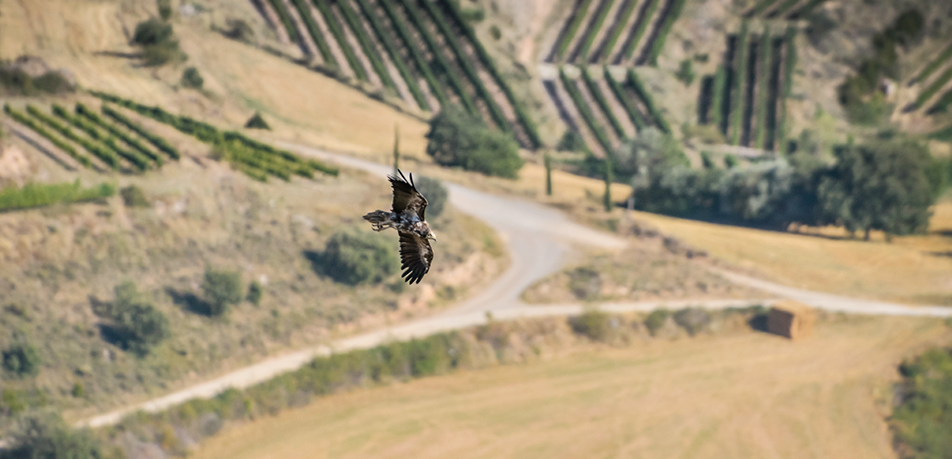GREAT AUTUMNAL TRAVELERS

By Jose Luis Gallego, naturalist and environmental communicator.
The hot days of summer are over. The vineyard awaits the tasks that follow the harvest, and work is underway in the winery to make the most of the crop. Meanwhile, the sky fills with the constant coming and going of an exceptional group of southbound travelers.
As every year, the large flocks of migratory birds that arrived in our fields in the spring have finished their breeding season and are heading to their wintering grounds. Large soaring birds like the white stork, birds of prey like the Egyptian vulture or the European honey buzzard, and birds of all species and sizes take to the skies and head to Africa before the onset of fall.
Their departure, however, will not leave our fields, forests and vineyards devoid of bird life. They will soon welcome other birds, arriving in the coming weeks from northern countries to brighten our wintry landscapes for the next few months.
In Eurasia, climatic contrasts clearly define the phenological stages of living organisms. This is why a great many bird species opt for long journeys in search of fair weather. Unlike mammals and reptiles that hibernate to survive climatic extremes, these birds travel from our rural landscapes to the pre-Saharan plains or even further, crossing the vast Sahara to reach the Great Lakes region.
We're talking about a feat accomplished by birds as tiny as the barn swallow. Weighing just twenty grams, it travels more than three thousand kilometers, crossing the sandy expanse of the world's greatest desert without water to drink or trees to perch on.
OVER FIVE BILLION BIRDS
According to scientific bird migration studies, every year around five billion birds, belonging to more than two hundred different species, undertake the journey between the European continent and sub-Saharan Africa. Countless birds of all shapes and sizes obey their ancestral survival instinct and travel peculiar routes that are often mysterious due to their inexplicable nature.
The same species, traveling at the same time of year through the same landscapes. It is among the most extraordinary natural phenomena, which has fascinated humanity since time immemorial.
Most are familiar with the well-known example of the messenger pigeon, carrying dispatches between towns and villages, often across great distances. Another story comes to us from Ancient Rome. At the end of the popular chariot races, which inspired unbridled passion among the townspeople, the champions' followers would climb the rooftops and catch swallows in their nests to dye their wings the winning colors. When the birds returned to their wintering grounds in the African provinces of the vast Roman Empire, the soldiers stationed in these faraway outposts would see the colors and cheer the champion as the birds flew past.
TRAVELING WITHOUT A MAP
But... how do birds find their way? How do they manage to follow such a specific route, generation after generation? We resolved the mystery of bird migration some time ago thanks to data provided by scientific bird banding: an identification system that involves capturing birds in a harmless manner to attach a ringed tag to their leg and immediately releasing them. The hope is that, if captured again, the tagged birds can provide information about their migration patterns.
Thanks to this system, we now know that one of the most common orientation methods used by migrating birds is geographical recognition.
Birds are guided by irregularities in the terrain, which they use to trace and adjust their routes. But what about species that fly at night without the aid of visual references? Here data has shown that birds are guided by the stars, with the sky providing points of reference just like the landscape does.
So, what if it's cloudy? When there is zero visibility, magnetic fields also play an important navigational role. Birds have an interior compass of sorts, a natural GPS system that lets them follow a consistent course between specific points. They do so by paying attention to geo-localization references anchored in their ancestral memory, their genetic code.
This would explain, for example, how a bee-eater born in a northern Spanish village in the spring can make its first trip to its parents' wintering grounds even when flying alone, at night and in cloudy weather. A true lesson of nature.
